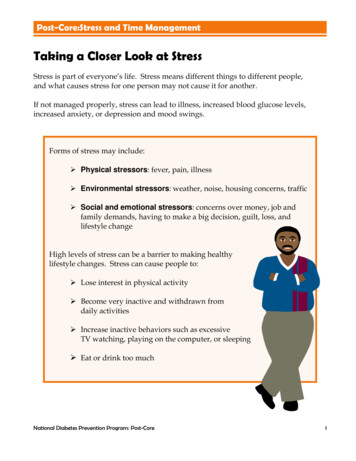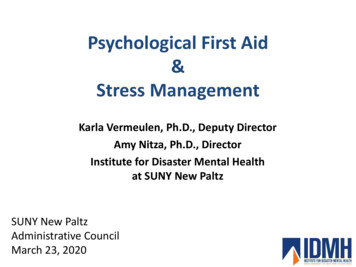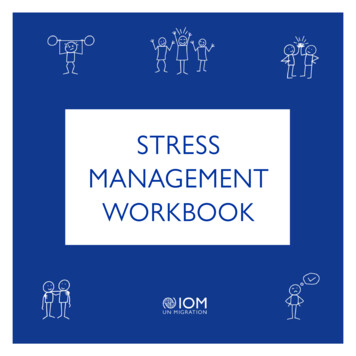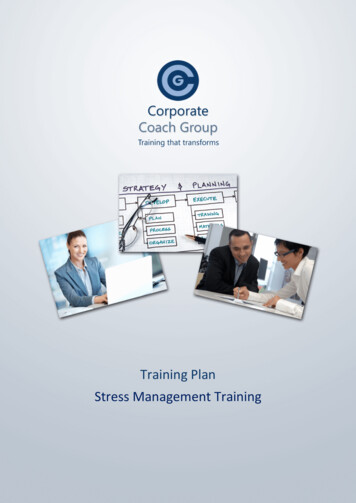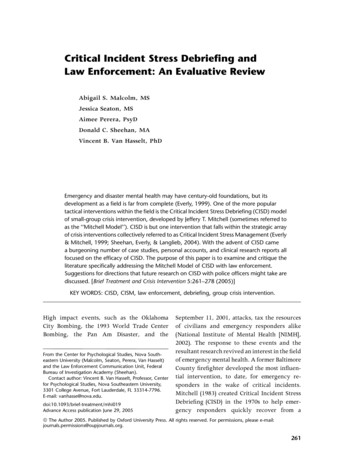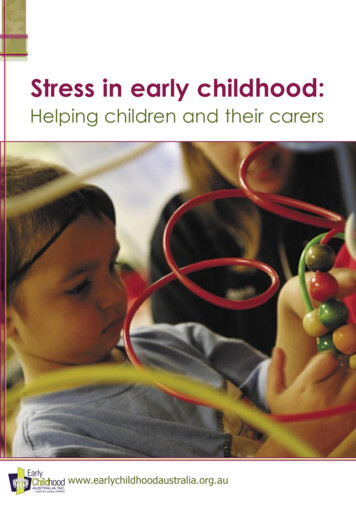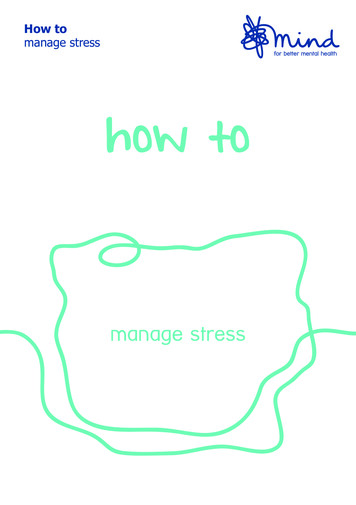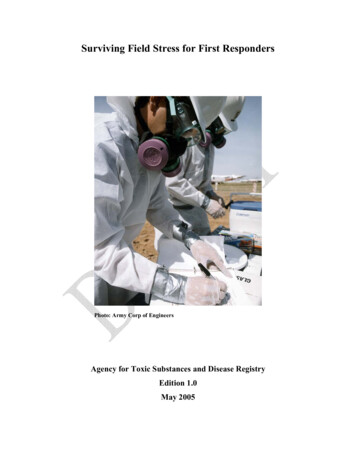
Transcription
Surviving Field Stress for First RespondersPhoto: Army Corp of EngineersAgency for Toxic Substances and Disease RegistryEdition 1.0May 2005
Surviving Field Stress for First RespondersPrefaceThis training manual provides an introductory overview of the effects that psychologicalstressors associated with field work has on the mental and physical health of those calledto respond to emergencies. The advice and the resources given are based on the bestscience to date and this book will be updated as the knowledge base on the prevention ofstress-related health conditions advances. However, the information contained herein isno substitute for a physician’s advice regarding health conditions.PurposeThis book provides an overview of the physical, emotional, and mental stressors firstresponders face when called to a technological disaster or terrorist attack. It givespractical coping techniques and lists resources for dealing with stress. The purpose of thismanual is to help the responder and those they assist be prepared for the stresses of 21stcentury disasters.2
Section I. Stress 101ADefinition of StressPsychological stress is a normal reaction to a threat or disturbing change in theenvironment. Stress produces both psychological and physical responses. Together, theseresponses lead to a biochemical cascade which sets off a flight-fight or freeze reaction bythe body. (See Figure 1 for a fuller description)All animals, from simple reptiles to complicated humans, have this flight or fightreaction. It is a survival mechanism that prepares all animals to run or fight for their lives.A first responder on a call could experience increased heart rate and rapid breathing, asthe body also redirects blood from the guts to the leg and arm muscles. These effects ofthe fight-or-flight response could cause indigestion, rapid breathing, and heart pounding;but the response also brings about a general increase in physical energy and strength.3
Figure 1. The Stress Response or Flight/Fight or Freeze Reaction.Once a change (noise, sound, smell, pain, etc.) is noticed and confirmed as a threat by the partsof the limbic system—the brain’s alarm center. The limbic system then directs the sympatheticnervous system (SNS) to alert the body. The SNS does this by stimulating the adrenal medulla,located near the kidneys, to release the adrenaline-like compounds, epinephrine andnorepinephrine, into the bloodstream. The limbic system also tells the hypothalamus—thecontrol center of the brain—to signal the tiny pituitary gland near the brainstem to create otherchemical signals to help further activate the body, As a result of action on the pituitary, theadrenal cortex releases cortisol, an important stress hormone. The release of all thesechemicals causes important changes in the body’s ability to respond to threats such as increasedenergy, heart rate and blood sugar; increased arousal and pain relief. (Charney, 2004)4
Sidebar:The fight-or-flight reaction also has a “freeze” component to it. The freeze response isbest illustrated by the “deer in the headlights” syndrome. The purpose of the freezereaction, which is bad if you are a deer on a road at night, is an escape mechanism. In thewild, antelopes will freeze when seized in the jaws of a cheetah. Rather than biting themfurther, the cheetah will eventually drop the still prey and go off in search of more. Thefreeze reaction lets the antelope, if not too injured, jump up and run away. People,especially children, can also exhibit this freeze response, especially when they areambushed or suddenly terrorized. A recent example of this occurred during an ambush inthe U.S.-Iraq war as this eyewitness account reveals,“We were going though this town and all of a sudden we got ambushed,” Lopez said.“I was really scared. You could just hear bullets flying by. They were firing artilleryalso. And it’s just scary. I never felt that much fear in my life. Ever. When I got hit[in the shoulder] it felt like somebody just pushed me and it hurt at the time,” Lopezsaid. “My whole body went asleep. I couldn’t do anything. I couldn’t move anything.I felt like I was paralyzed.”—(from ABC news, copyright permission granted)The stress response (fight-or-flight/freeze) is a normal reaction that leads to an increasein arousal and ability to deal with threat. In the absence of a continued threat, the bodyrelaxes and goes back to its normal state of tension. Small doses of daily stress are notunhealthy at all. They are part of life and the body is adapted to handle them. In times ofextreme stress, however, this stress response can become turned on at all times, with norelaxation. This can have serious physical and psychological consequences. There areways to turn off the stress response. One purpose of this training manual is to teach youvarious ways to handle psychological and physical stress.5
Stress Spectrum - Acute, Chronic, and Traumatic StressDifferent categories of stress exist. Acute and chronic stress differ by the time span inwhich they occur, e.g., short or long-term. And, also, there exists a stress spectrum whichdiffers in the intensity of the stimulus causing the stress and the possible responses to itfrom mild everyday stress, to distress, and at the extreme end, traumatic stress.Acute, or short-term stress is what happens when we respond immediately to a suddendanger. A near miss in traffic is an example of an acute stress. An oncoming car is thethreat and we respond by getting out of the way; little time separates stressor andresponse.Stimulus Appraisal of Threat ResponseChronic, or long-term stress occurs over a long period and does not present an easy orquick solution. The day-to-day hassles of life, a bad job, or clogged traffic can be sourcesof chronic stress. Chronic stress tends to have more negative effects on health than acutestress because it stimulates long-term flight-or-flight reactions that can knock the body’ssystems out of balance. Severe chronic stresses, such as an abusive childhood or a longterm illness, are called adversity.Table 1. Symptoms of Chronic StressThinkingEmotionsBehaviorShort attention spanMood swingsImpulsivenessPoor concentration (mind drifting off ofthe subject)AgitationInsomnia orhypersomniaProblems with memory (forgetfulness)IrritabilityInertiaDifficulty with decisionsInsecurityDependencySlowed thinkingApprehensionArguingInability to see ietyPacing6
A traumatic event is a very intense stressor which is outside of experience of everydaylife. Examples include being in a tornado, fire, or being subjected to violence, combat, orterrorist attack. In its Diagnostic and Statistical Manual of Mental Disorders, DSM-IVTR, 4th edition, the American Psychiatric Association defines a traumatic event as lifethreatening situation that it evokes feelings of intense fear, horror, orhelplessness.(American Psychiatric Association, 2000) Traumatic events can leave bothsurvivors and responders with physical and psychological injuries requiring treatment.Pre-event training and appropriate after care can help ease the stress reactions caused bythese extraordinary events.50403020Rate of PTSD100Acute Stress ResponderStressRapeNaturalDisasterTerrorist ActFigure 2. Rates of Post-Traumatic Stress Disorder (PTSD) by Event.As the stress of the event increases, so do the rates of stress-related disorders, such as PTSD.(Kaplan and Sadock, 1995; Fullerton et al., 2004; Foa, 1997; Burkle,1996; North et al.,2002)A disaster is a traumatic event that affects a whole community or communities. Thisdefinition of a disaster comes from the Substance Abuse and Mental Health ServicesAdministration (SAMHSA):An occurrence such as a hurricane, tornado, earthquake, explosion,hazardous materials accident that causes human suffering or createscollective human need that requires assistance to alleviate.Disasters have also been defined as situations of massive, collective stress (Burkle,1996).7
Effects of Disaster Stress on Psychological HealthScientists and clinicians have studied the effects of stress from natural disasters onsurvivor’s psychological and physical health since the 1940s. They recognized that somepeople who have been exposed to various natural disasters could develop psychologicalinjuries, such as major depression, chronic anxiety, and post-traumatic stress disorder.As research on the psychosocial effects of disasters progressed, factors affecting thepsychological injury rate became better known. One of the main determinants is theindividual’s experience during the disaster: Did they suffer first- or secondhand from the disaster? Did they suffer personal losses? Were they personally injured or witness the suffering of others?Another important factor is the social response to the disaster. How widely is the socialnetwork disrupted and how quickly does outside support and aid arrive for the victims?On average, 90% of people who live through a natural disaster will suffer onlytransient—or no—emotional effects from it (Burkle 1996). Why is this? Because, incollective disasters, rather than individual misfortunes, social support provides importantresources for coping. Also, natural psychological resilience protects people after suddendisasters. It is normal to be sad and emotionally distressed in the aftermath of a naturaldisaster. But, most people rebuild their internal and external world fairly successfully,relying on family, friends, community, and their own coping skills.Technological, or human caused disasters, are a fairly new category of disaster. Thistype of disaster includes plane crashes, building collapses, hazardous material(HAZMAT) incidents, and intentional releases of chemical, biological, and nuclearmaterials by terrorists.People who live near a hazardous waste site may also chronically experience the stress oftechnological disasters. Technological disasters that leave widespread contamination poseunique stresses for victims that may make it harder for them to adapt to, in comparison8
with victims of natural disasters. A contributing factor may be that in natural disasters, noone is to blame, while blame may be assigned for malfunctions in human-made systems.Additional stressors that can occur with technological disasters include fear of invisiblechemical or radiological exposure, or if exposed, worry and uncertainty regardingpossible future health effects.In addition to direct health effects, exposure or possible exposures to toxic substances cancause people to experience considerable worry and uncertainty. There have been anumber of studies of the levels of psychosocial stress in communities affected byexposures to toxins. These studies show a pattern of long-term sub clinical stress inaffected populations (Baum and Fleming, 1993). This is because contamination from atechnological breakdown can take years to decades to clean up. These types of disastersmay damage the social fabric because of the concern over responsibility and the numberof agencies, communities, and companies involved in the cleanup. The social conflict thatcan ensue during cleanup can reduce the available social support for victims. Suchsupport is vital for recovery from disasters (Couch and Kroll-Smith, 1991).Table 2. Psychosocial Responses of Communities to Environmental ContaminationFear and uncertainty over the possible health effects of exposureFeeling a loss of control over the present and futureAnger over the loss of security and safety within the communityConfusion brought about by trying to understand various government documentsCommunity conflict over who is to blame and what actions to takeConcerns over economic losses (e.g., property devaluation, doctor bills, and businesslosses)Feelings of being stigmatized and isolated because of living near a hazardous waste siteFrustration of dealing with bureaucratic agenciesFrustration of being accused of “overreacting”Source: From ATSDR Report of the Expert Panel Workshop on the Psychological Responses to HazardousSubstances (ATSDR 2000).9
Terrorist attacks result in greater psychological casualties than natural disasters ortechnological accidents. Deliberate cruelty and violence by others is the most damagingof all types of stress (Lifton 1991). A recent study of the Oklahoma City bombing foundthat 45% of the people at the site had a psychological injury and 30% had bomb-relatedpost-traumatic stress disorder (North et al. 2002).Sidebar.“When you’ve worked as long as I have, you get to see all kinds of scenes. I even went tothe Kobe earthquakes. But the Tokyo sarin attack was different. That was really and trulyhell.”—Minoru Miyata, TV Tokyo (Murakami H. 2001)Effect of Stress on Physical HealthPsychological stress is one of many factors besides diet, exercise, genetics that affectphysical health. A normal load of daily stress does not significantly degrade health.Heavy burdens of chronic stress or intense bursts of traumatic stress can over timenegatively impact health. The way stress interacts with physical health is subtle.One of the areas where this interaction is being researched is the effect of stress on thecardiovascular system. Research shows that acute stress may serve as a trigger for a heartattack in people with pre-existing coronary artery disease (CAD). For example, someonewith pre-existing CAD is more at risk of a heart attack following a sudden emotionalupset than someone with CAD but without the sudden emotional upset (Sheps DS et al.2002). norepinephrine Heart rate, Cardiac Output, Blood Pressure epinephrine( 5 mm Hg)Figure 3. Cardiovascular Stress Response10
Although acute stress may trigger a heart attack in those predisposed to heart disease,researchers believe that the chronic effects of stress on the heart are what can lead toincreased rates of cardiac illness and death after a myocardial infarction. In 1994,Frasure-Smith et al. conducted a study showing that “major depression in patientshospitalized following an MI [myocardial infarction] is an independent risk factor formortality at 6 months. Its impact is at least equal to that of left ventricular dysfunction(Killip class) and history of previous MI.” According to this study, if a patient hasdepression post-MI, their risk ratio for death is 4 times that of nondepressed, post-MIpatients.The exact mechanisms by which a stress-related disease like depression affects deathrates post-MI is not yet fully known. One leading hypothesis is that depression leadspeople to neglect medication and self-care post-MI. The other two hypotheses involve theinteraction of psychological and physical factors that come together to alter the functionof the circulatory system. Depression alters the function of the autonomic nerves thatserve to regulate the heart’s rhythm (Frasure-Smith 1993).A more recently tested idea is that depressed patients experience changes in plateletfunction. The theory is that the chemical changes involved in major depression may causeplatelets to form clots more easily than normal. Platelets are involved in how well theblood clots and alterations in their ability to clot can increase the risk of heart attack. TheSertraline Anti-Depressant Heart Attack Randomized Trial (SADHART) evaluated theeffects of selective serotonin reuptake inhibitor (SSRI) antidepressants given to depressedpatients who had just suffered an MI. That treatment resulted in decreased clotting abilityin platelets and increased patient survival (Serebruany VL et al. 2004). Stress-relatedchemicals, such as norepinephrine, can also irritate the tissues that carry the heart’selectrical activity. That can cause our hearts to beat irregularly if we have underlyingheart disease (Krantz and McCeney 2002).Although hypertension has other risk factors, chronic stress can contribute tohypertension in people who have the right genetic predisposition. The risk of infection is11
higher when we are suffering from chronic stress. That is because of the immune systemis suppressed due to the long-term stress-related increase in cortisol release. Autoimmunedisorders, such as rheumatoid arthritis, can flare up during stressful periods. Thegastrointestinal system is not immune to the effects of chronic stress, either; the conditioncalled irritable bowel syndrome is related to psychological stress. Psychological stress isthought to be involved in increasing susceptibility to acute attacks in asthmatics.Figure 4. Physical Health Effects of StressProtective Factors from Stress ReactionsPeople are not helpless against the effects of psychological stress. For one thing, thereare ways to turn off the fight or flight response and to relax. We will talk about thesespecific stress management techniques later. Second, we all possess innate stress buffers.Stress buffers include such things as: coping skills, resilience, social support, and selfcare.Coping SkillsCoping skills are automatic mental ways in which we deal with stress. Coping stylescolor the way we think and therefore feel about a situation. There are three main types ofcoping. Some types automatically fit a certain situation better than others.The first coping type is called appraisal focused coping. This coping style involvesseeking out patterns and interpreting the meaning in events. At best, this involves the use12
of logical analysis and mental preparation. At its worst, this type of coping can involvedenial or not thinking about things when you need to.The second type of coping is problem-focused coping which involves finding practicalsolutions to problems. At best, this involves seeking information and problem solving,and taking action to solving problems. However, this way doesn’t work well and in factmay cause frustration if applied to chronic, not easily solved situations.The third type of coping is emotion-focused coping which means regulating one’semotions during a stressful situation. At best, this works to control emotions understress; at worst, leads to resigned acceptance instead of taking actions to change thingswhen they can be changed.Everyone has their own default, automatic coping style. First responders tend to cope byseeking to understand situations, gaining mastery through individual and interpersonalaction and seeking to extract philosophical meaning from situations. (McCammon, 1988)It is important to know that coping skills can be learned and are taught by work withcounselors and psychologists. So, if you tend to use just one kind, you can learn othersand come up with a more flexible coping strategy.Resilience“Resilience is a universal human capacity to face, overcome, and even be strengthened byexperiences of adversity.” —International Resilience ProjectSidebar:Resilience FactoidIt is a sign of resiliency to seek help when in trouble. It makes one vulnerable to be afraidto ask for help (Adshead 2000).13
Resilience was originally described in the 1960s in children who had come from verytroubled backgrounds. These children had been poor and abused. Yet, they had gone onto be very productive citizens. The pathologic models of the time predicted that no onecould overcome adversity of this type. So, it fascinated the psychologists of the day. Theydiscovered that these children were gifted in the way they dealt with people. The resilientchildren reached out to teachers, nonabusive family members, or neighbors to mentorthem so they could grow and adapt normally in spite of their disadvantaged backgrounds.Since that time, the elements of resilience have been described further and it is nowbelieved that you can teach resilience to adults.Table 3. Seven Components of Adult tiativeMoralityCreativitySource: (Wolin S and Wolin S. 1993, p.67–76).Resources1. The Road to Resilience. Brochure available from the American PsychologicalAssociation. 1-800-964-2000 or www.helping.apa.org.2. International Resilience Project. See their Web site at URL:http://www.resilnet.uiuc.edu/library.3. School Violence Prevention. Characteristics of resilient individuals. US Department ofHealth & Human Services, Substance Abuse and Mental Health Services Administration,Center for Mental Health Services. Available at nce/part1chp8.aspSocial SupportOn both an individual and group level, social support forms an important protection fromstress for both adults and children. For individuals, “in more than 100 empirical studies,social support has been tied to reduced health risks of all kinds ” (Taylor, Dickerson,14
Klein 2002). Conversely, a study found that having few social contacts resulted in a 2.75greater risk of death after a first heart attack than in people with greater social support(Welin, Lappas, Wilhelmsen 2000). Long-term relationships, particularly a goodmarriage, has been found to have a positive effects on both men’s and women’s health.(Lasswell, 2002)There are many theories as to why social support is so important. Some say it is simplybecause knowing people provides practical, problem solving assistance. Yet, if personalresources and socioeconomic status are factored out of studies, emotional support alonehas moderating effect on stress and a very positive effect on human health. Variousacademic centers are working on the chemical cascade by which the human brainresponds to positive social interactions.SidebarInteresting Factoids about Social Support Men may be more responsive to social support than women even though womentend to seek support more often than men and are more negatively affected by itslack. It’s not just the number of relationships you have but whether or not they arepositive that count as social support. For example, it has been found that anunhappy marriage, although harmful to both genders, has more of a negativeeffect on women’s mental and physical health. (Lasswell, 2002)ExerciseThe physically harmful effects of chronic stress can be reduced by moderate exercise(McEwen 1998). A 1996 study found that people who aerobically exercised had lowerheart rate, blood pressure when faced with acute stress (Anshel 1996).15
References—Section IABC News. Healing Tents, Soldiers Treated at 12-Acre Desert Hospital in Kuwait. DianeSawyer. March 27, 2003. Available from night/iraq GMA030327 MilitaryHospitalAdshead G. 2000. Psychological therapies for post-traumatic stress disorder. Br JPsychiatry 177:144–8.Agency for Toxic Substances and Disease Registry (ATSDR). 2000. Report of the expertpanel workshop on the psychological responses to hazardous substances. Tucker PG,senior editor. Atlanta: US Department of Health and Human Services. p. 40.Anshel MH. 1996. Effects of chronic aerobic exercise and progressive relaxation onmotor performance and affect following acute stress. Behav Med 21(4):186–96.American Psychiatric Association, Diagnostic and Statistical Manual of MentalDisorders, Fourth Edition, Text Revision. Washington, DC: American PsychiatricAssociation, 2000.Baum A, Fleming I. 1993. Implications of psychological research on stress andtechnological accidents. Am Psychol 48(6):665–72.Burkle FM. 1996. Acute-phase mental health consequences of disasters: implications fortriage and emergency medical services. Ann Emerg Med 28:119–28.Charney, DS. 2004. Psychobiological mechanisms of resilience and vulnerability:implications for sucessufl adaptation to extreme stress. American Journal ofPsychiatry,161: 195-216.Couch SR, Kroll-Smith JS, editors. 1991. Communities at risk: collective responses totechnological hazards. New York: Peter Lang.Davidson, JRT. 1995. Posttraumatic Stress Disorder and Acute Stress Disorder. In,Kaplan HI and Sadock BJ, editors. Comprehensive Textbook of Psychiatry, VI.Baltimore, Maryland: William and Wilkins.Foa, EB. 1997. Trauma and women: course, predictors, and treatment. Journal of ClinicalPsychiatry, 9, 25-28.Frasure-Smith N, Lespearance F, Talajic M. 1993. Depression following myocardialinfarction: impact on 6-month survival. JAMA 270(15):1819–25.Fullerton CS, Ursano RJ, Wang L. 2004. Acute Stress Disorder, Post-traumatic StressDisorder, and depression in disaster or rescue workers. American Journal of Psychiatry161: 1370-1376.Krantz DS, McCeney MK. 2002. Effects of psychological and social factors on organicdisease: a critical assessment of research on coronary heart disease. Annu Rev Psychol53:341–69.16
Lasswell, M. 2002. Marriage and family. In: Kornstein, SG and Clayton, AH. Women’smental health, a comprehensive textbook. New York, Guilford Press.Lifton RJ. 1991. From Hiroshima to the Nazi doctors: the evolution of psychoformativeapproaches to understanding traumatic stress syndromes. In: Wilson JP, Raphael B,editors. International handbook of traumatic stress syndromes. New York: Plenum Press.McCammon S, Durham TW, Allison EJ, Williamson, JE. 1988. Emergency worker’scognitive appraisal and coping with traumatic events. Journal of Traumatic Stress 1(3):353-372.McEwen BS. 1998. Seminars in medicine of the Beth Israel Deaconess Medical Center:Protective and damaging effects of stress mediators. New England J Med 338(3):171–9.Murakami H. 2001. Underground. New York:Vintage Books. p. 29.North CS, Pfefferbaum B. 2002. Research on the mental health effects of terrorism.JAMA (288)5:633–6.Serebruany VL, Glassman AH, Malinin AI, Nemeroff CB, Musselman DL, van Zyl LT,et al. 2003. Platelet/endothelial biomarkers in depressed patients treated with the selectiveserotonin reuptake inhibitor sertaline after acute coronary events: the Sertaline AntiDepressant Heart Attack Randomized Trial (SADHART) platelet substudy. Circulation108(8):939–44.Sheps DS, McMahon RP, Becker L, Carney RM, Freedland KE, Cohen JD, et al. 2002.Mental stress-induced ischemia and all-cause mortality in patients with coronary arterydisease: results from the psychophysiological investigations of myocardial ischemiastudy. Circulation 105(15):1780–4.Taylor, SE, Dickerson SS, and Klein, LC. 2002. In: Snyder CR, Lopez SL, editors.Toward a biology of social support. Handbook of positive psychology. Oxford: OxfordUniversity Press. p. 556–68.Welin C, Lappas G, Wilhelsen L. 2000. Independent importance of psychosocial factorsfor prognosis after myocardial infarction. J Intern Med 247(6):629–39.Wolin SJ, Wolin S. 1993. The resilient self: how survivors of troubled families rise aboveadversity. New York: Villard Books.17
Section II. Field Responses and StressPredeployment PreparationPredeployment training is crucial. It is probably impossible to be too prepared for thefield. Information is the best “cure” for anticipatory stress. Pre-incident training can rangefrom on-the-job safety, to technical skills, to human elements training (i.e., helpingemotionally distressed victims during a response). Disaster orientation is a basicintroduction to the elements of field work. Stress education involves learning how torecognize normal stress reactions and simple skills and rules for managing stress during aresponse. It includes learning post-response steps for recovery.Learning to recognize and manage what stressors you can reduces your chances of beingnegatively affected by stress. To make informed management decisions, field supervisorsneed an awareness of all types of stressors responders face and the possible toll they cantake on personnel.During the DisasterDisaster StressorsFirst responders to disasters are exposed to physical and mental stresses that combine andinteract. Psychological and physical stressors can add up to produce a threshold effectthat overwhelms and degrades responder alertness and strength. This has importantpersonal safety effects. To increase safety during a response, first responders and theirmanagers need to learn how to recognize all stressors, whether physical, mental, oremotional.Physical StressesHeatWorking in a hot environment—especially when wearing personal protective equipment(PPE), as for a HAZMAT incident—can put responders at risk for heat-related disorders.18
All responders should be familiar with the signs and symptoms of heat stroke and heatexhaustion, the most serious of the heat-related illnesses.Symptoms of heat exhaustion include heavy sweating, muscle cramps, fatigue, weakness,paleness, cold or clammy skin, dizziness, headache, nausea or vomiting, and fainting. Ifunrecognized and untreated, heat exhaustion can progress to heat stroke. The symptomsof heat stroke include high body temperature (oral temperature 103 F); red, hot dry skinwith no sweating; rapid pulse; throbbing headache; dizziness; nausea; confusion;disorientation; and coma. Onset of heatstroke is a medical emergency. Heat exhaustionand heat syncope (fainting) lasting longer than 1 minute with signs of mental changesalso need medical intervention. These signs and symptoms are important to knowbecause mental changes, such as disorientation and confusion, are not only signs ofpsychological distress but of physical distress. (Donoghue et al., 2003) In hot workingconditions, coworkers and supervisors should make sure a mentally confused responder isnot medically ill with heat stroke or exhaustion.First Aid for Heat Exhaustion and Heat StrokeIf you see any of these above signs of heat exhaustion or heat stroke, you may be dealingwith a life-threatening emergency. Have someone call for immediate medical assistance while you begin coolingthe victim.Then, do the following: Get the victim to a shady or air conditioned area. Cool the victim rapidly using whatever methods you can. For example,immerse the victim in a tub of cool water; place the person in a cool shower;spray the victim with cool water from a garden hose; or sponge the person withcool water. If the humidity is low, wrap the victim in a cool, wet sheet and fanhim or her vigorously. Monitor body temperature, and continue cooling efforts until the bodytemperature drops to
Rate of PTSD Figure 2. Rates of Post-Traumatic Stress Disorder (PTSD) by Event. As the stress of the event increases, so do the rates of stress-related disorders, such as PTSD. (Kaplan and Sadock, 1995; Fullerton et al., 2004; Foa, 1997; Burkle,1996; North et al., 2002) A disaster is a traumatic event that affects a whole community or .

